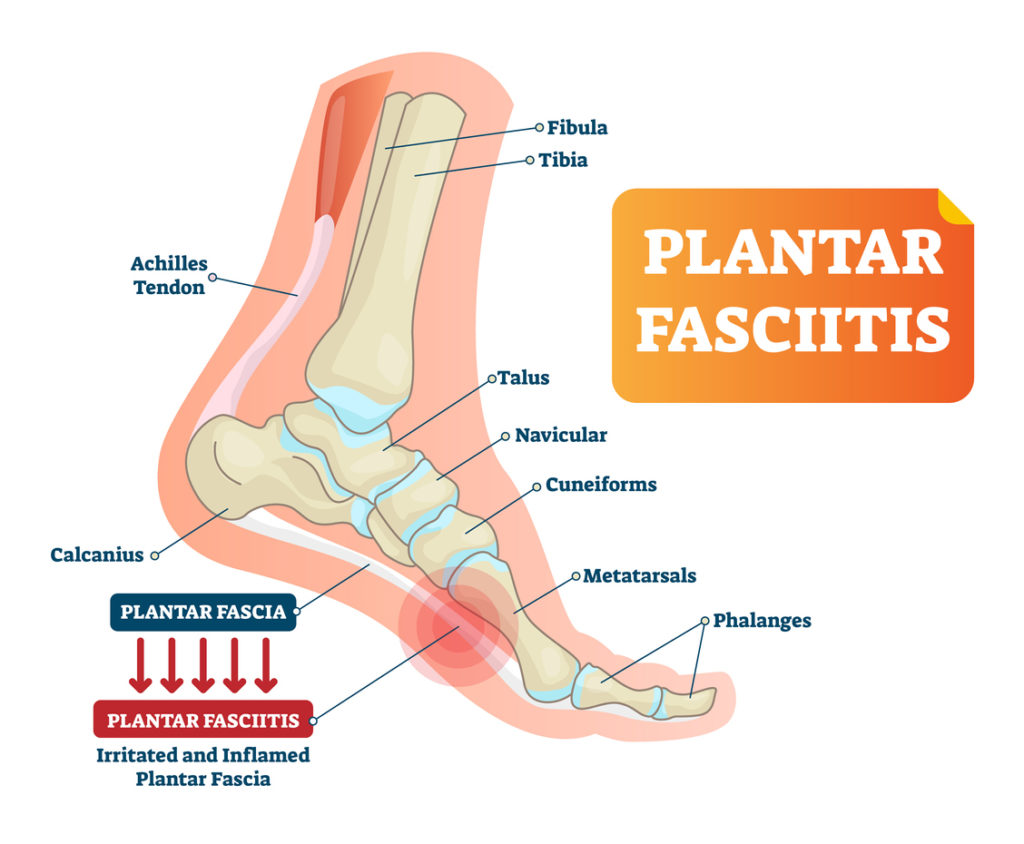PLANTAR FASCIITIS: IS HEEL PAIN LIMITING YOU?
You may have experienced a stabbing pain when you take your first steps in the morning. Gradually, the pain in your heel will reduce as you move around more. You might think it has gone. However, it may return when you walk after long periods of sitting or standing. This sharp pain you feel in your heel when you walk is a symptom of plantar fasciitis.
This condition results from the inflammation of the tissue that runs across the sole and attaches the heel to the toes. The pain associated with plantar fasciitis is worse as you take your first steps of the day. Both males and females, especially runners may suffer from these symptoms. However, those who wear high-heeled shoes or are overweight have a high risk of developing this condition.
Symptoms of plantar fasciitis
Strain injury on the bowstring-like ligament (plantar fascia) that stretches underneath the sole can lead to its inflammation. It can also cause micro-tears to the tissue where it attaches to the heel bone. Pain at the bottom of the foot, tenderness, and stiffness are the major symptoms of plantar fasciitis. The “first-step pain” when you wake up in the morning is an indication of the condition.
Tension in the surrounding muscles can lead to pain beyond the heel. The tenderness around the heel may also affect the entire sole. Plantar fasciitis can make your foot stiff especially in the mornings or when you stand up after sitting for a long period. This condition can make walking difficult. Sufferers may not be able to walk barefooted on hard surfaces.
Causes of plantar fasciitis
The inflammation of the plantar fascia ligament may result from the following:
1. Repetitive strain injury
Jumping injury from landing, excessive walking or running, and wearing footwear with inadequate support can cause strain injury. The overuse and strain of the band of tissue that attaches the toes to the heel can lead to plantar fasciitis. The injured ligament becomes inflamed causing a stabbing pain when you walk.
2. Diseases
Certain diseases such as reactive arthritis can also cause plantar fasciitis. Such a health condition can affect the tissue that connects your toes to your heel. The plantar fascia ligament supports the arch in the foot by acting as a shock-absorbing bowstring. Too much stress on this tissue results in small tears. Continuous stretching can lead to inflammation of the ligament. However, the cause of some cases of plantar fasciitis isn’t clear.
Risk factors
Certain factors increase the risk of plantar fasciitis. They include:
-
- Obesity: Excessive weight puts extra stress on the plantar fascia.
- Age: People are likely to develop plantar fasciitis as they become older. Consequently, this condition is common in individuals that are 40 years of age.
- Occupation: Certain professions such as teaching can keep you on your feet for hours. Individuals who stand or walk on hard surfaces for long periods during work hours are likely to develop symptoms.
- Certain exercises: Activities such as jumping, aerobic dance, ballet dancing, and long-distance races can put extra stress on the heel. Individuals that engage in such activities may develop plantar fasciitis.
- Foot structure: Tight calf muscles, high arch, and being flat-footed can affect the distribution of your weight while standing. The extra stress on the plantar fascia ligament can strain the tissue.
The consistent wearing of high-heeled shoes or footwear with thin soles can affect the plantar fascia ligament. An unusual gait can also stress the tissue.
Diagnosis
The doctor will examine your foot for tender areas to identify the location of the pain. The tenderness caused by plantar fasciitis is localized along the sole of the feet within the arch of the heel. Besides the physical examination, your medical history will help the diagnosis of the condition.

In cases where there is a fracture in the heel or a compressed nerve, the physician may request for imaging tests. An MRI or X-ray will help rule out other causes of pain in the heel. Plantar fasciitis may also result from underlying diseases.
Treatment of plantar fasciitis
Usually, the condition resolves on its own within some months. Most individuals suffering from plantar fasciitis recover after consistent non-operative treatment. The over-the-counter pain relievers such as ibuprofen and adequate rest can ease the heel pain and reduce swelling. Ice massages can also reduce the ache and inflammation.
Exercising and stretching not only prevent plantar fasciitis but are also helpful in the treatment of the condition. Shoe inserts can minimize the strain on the plantar fascia ligament. Wearing footwear with soft, cushioned soles can ease the irritation of the inflamed tissues.
Plantar fasciosis results when plantar fasciitis is left untreated, leading to the avascular scarring of the strained tissue. Blood supply to the resulting fibrous tissue is limited, causing more pain. Plantar fasciosis is resistant to inflammation reduction procedures used in the treatment of plantar fasciitis.
This is when Active Release Technique (ART) can be very beneficial. ART focuses on breaking up the fibrotic tissue that is causing pain and it helps reverse the cumulative injury cycle. An increase in blood flow will occur, resulting in tissue healing rather than repetitive trauma. ART treatments will focus on not only the painful spots but also how the tissue feels at the insertion of the plantar fascia onto the heel bone.
Prevention
Plantar fasciitis can be prevented through the following ways:
-
- Wearing footwear with adequate support.
- Use of orthotic shoe inserts to add extra support to the arch.
- Stretching and massage of tissue.
- Specific strength training to address weakness in the glutes, hamstrings, and calves.
Individuals who stand on hard surfaces for extended periods need to reduce stress on the plantar fascia. They can use soft and supportive arch inserts to avoid straining their plantar fascia ligament. Massaging the arch of the foot and surrounding tense muscles can help relieve pain triggered by plantar fasciitis. If you are experiencing any of the symptoms of Plantar Fasciitis, you should find a sports chiropractor in your area who has a good understanding of this condition.


